
Chondracanthus corymbiferus
Ornate Turkish Towel
23 July 2024
Big Beach, Vancouver Island, B.C., Canada
Tide: 0.2 feet at 08:45 PDT (measured at Ucluelet Tidal Station)
Weather: Mostly cloudy (90 % cloud cover), wind West 0 – 5 km/hour, sea smooth, low westerly swell, humidity 94%, 14 ˚C.
Moon: Waning Gibbous (93.5%, 18 days); Next Phase, Third Quarter, 27 July 2024 at 7:51 pm PDT; Previous Phase, Full Moon, 21 July 2024 at 3:17 am PDT.
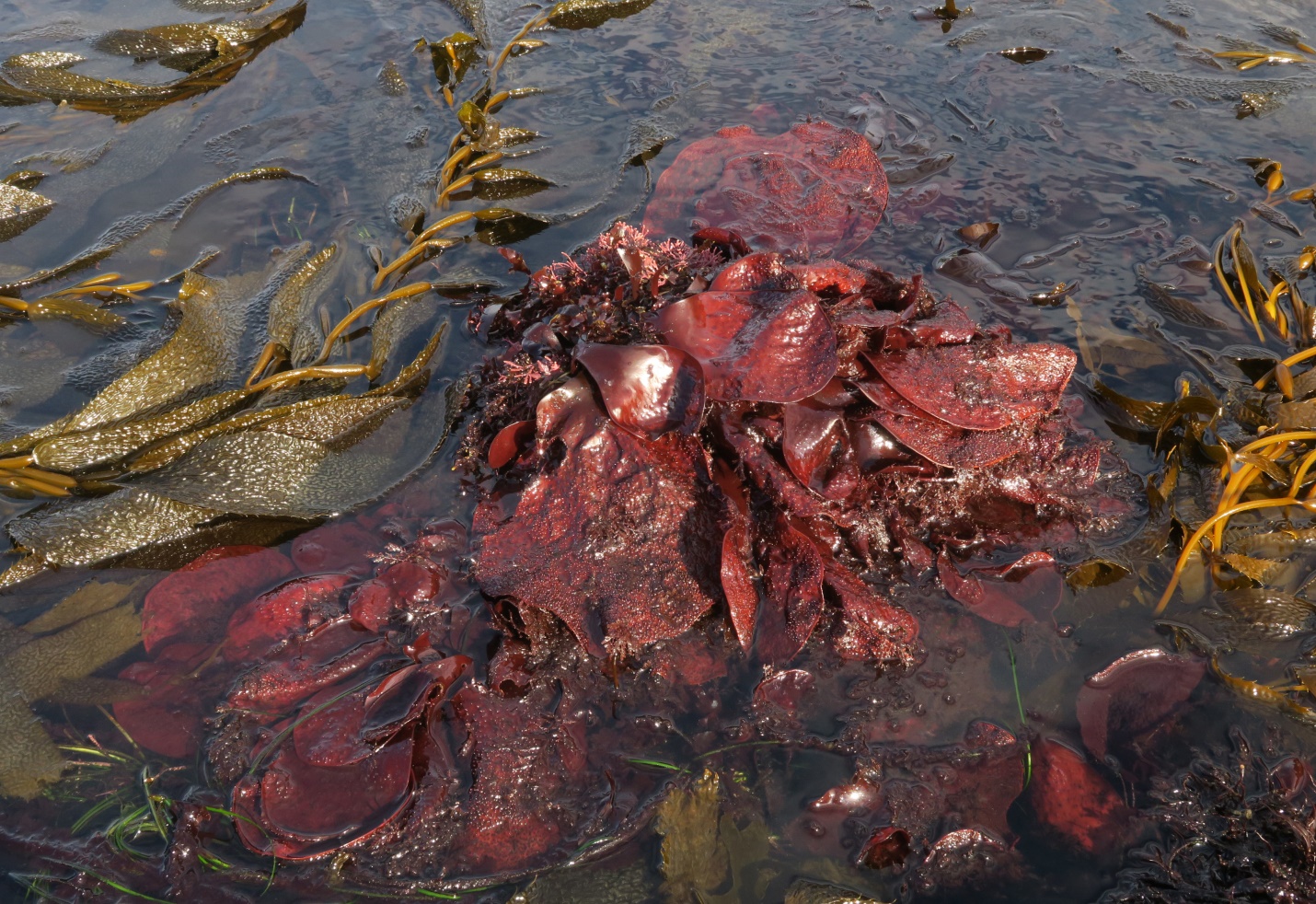
Figure 1: Blades of rich red Chondracanthus corymbiferus are exposed here as the boulder they grow from is temporarily deserted by the outgoing tide. The big ‘paddles’ of alga seem to lazily float, free from concern or any sense of hurry. Big Beach, Vancouver Island, B.C., Canada. July 23, 2024. Photo ID 27726 ©Seaweedwhisperings.com
Person 1:
Lumbering oaf.
Clumsy.
Messy.
The dark, curving, shoehorn-shaped apophysis (area between the holdfast and blade) is particularly noticeable when blade is broken off.
Distinct thick edge to the blades.
Slow moving, so slow that others can overwhelm it..., noticed the masses of “hitchhiker red” (Ceramothamnion coulteri, formerly Microcladia coulteri) on the more mature specimens of C. corymbiferus.
On mature washed ashore specimens I’ve seen elsewhere the rather ornate papillae seem to be “out of control” in design, and rather randomly placed without thought or care.
Clusters of C. corymbiferus seem to burst out of the substrate, then hang limply when the tide is out, or flop around lazily when submerged.
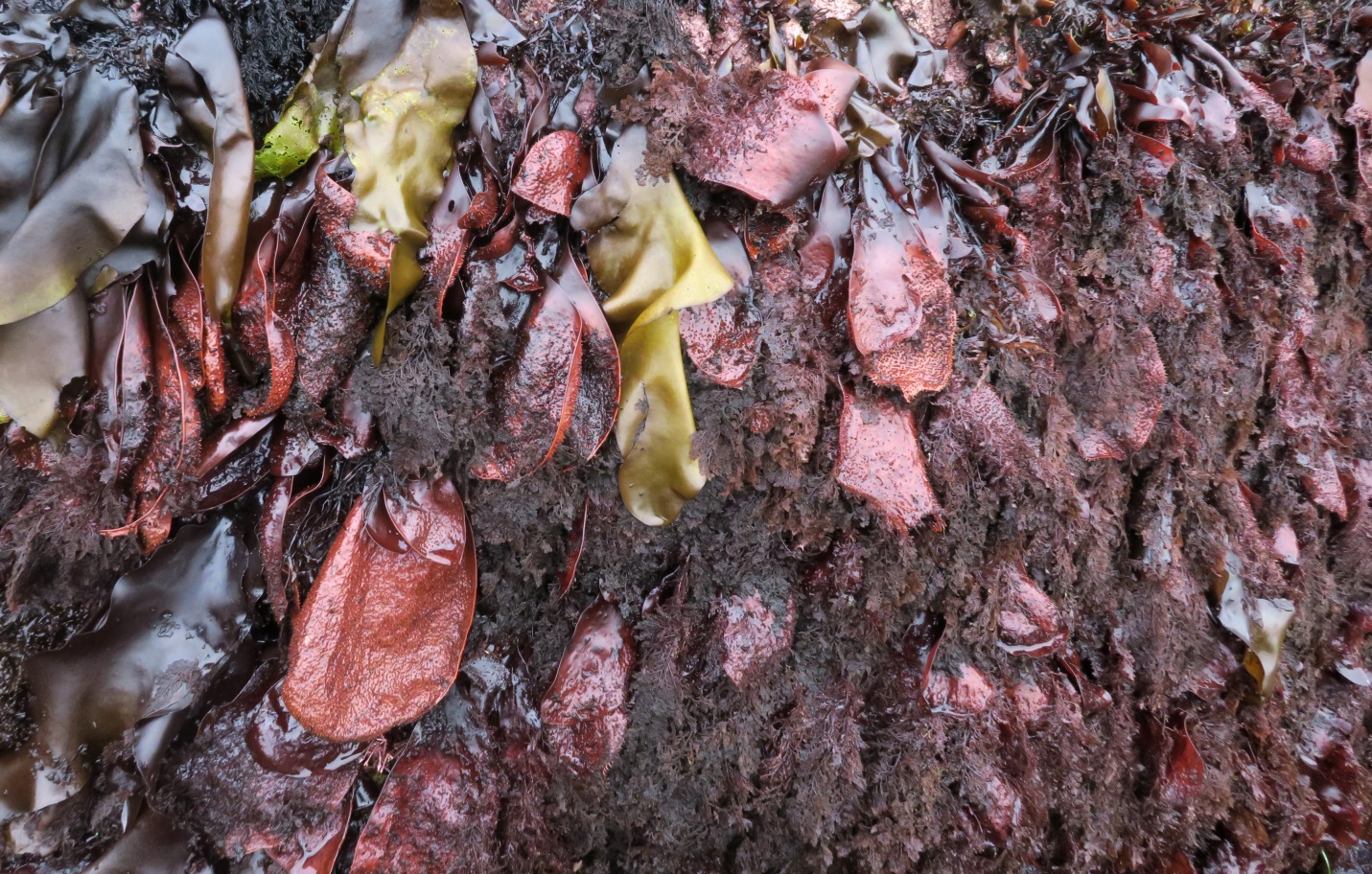
Figure 2: This very large boulder is draped with red algae. The more yellow/golden smooth blades are Mazzaella splendens, and the Chondracanthus corymbiferus blades are hosting a proliferation of tiny, lacy, multi branched Ceramothamnion coulteri – an seaweed that we have given the moniker of “hitchhiker red” due to its epiphytic nature. In this photo the hitchhiker red is dark brown looking in color and in many instances has all but obliterated its Ornate Turkish Towel host. Big Beach, Vancouver Island, B.C., Canada. July 22, 2024. Photo ID 27727 ©Seaweedwhisperings.com
Person 2:
Wide, rounded, generous blades – many look like pong paddles in shape.
Base of blade, the apophysis, is thick, dark, curled and strong.
You love the very low intertidal zone, Chondracanthus corymbiferus, and here you are prolific – the shoreline at low tide is rimmed with your intensely colored red blades.
The edge of your broad blade has a thicker, rolled margin. It looks like you don’t tear easily.
You do, however, float, really well! And you don’t put effort into that – you seem to be very ‘nonchalant’ and not giving it much care or attention.
You also really do attract a lot of the “hitchhiker red” seaweed to move in and ride along on your generous surfaces. There is really so much hitchhiker red on you that you look rather overtaken by it, but you don’t seem to mind – that is interesting to me!
Moving in gentle ocean swells your ‘paddles’ swing lazily and this had me wonder what about rougher times? I think that might become difficult in certain conditions. So perhaps you need to be mainly an underwater (subtidal) Chondracanthus.
Your blades seem to greatly narrow and affix to rock with little evidence of an anchor. Does it hold?
From all the blades we see broken at the end of their apophyses, and from all the nearly entire thalli we see cast ashore on this beach complete with their holdfasts, it seems evident that you can, at times, grow too large and the strong water action can pull you away.
Certainly at those times, the presence of all the “hitchhiker red” would only add to your sail and your potential peril. And it is really only at “the end” like this that you regret the hitchhiker red’s association with you. And even then I don’t think you feel betrayed so much as astonished. For a time all is good for both of you, and then all of a sudden, it’s all over – for both of you.
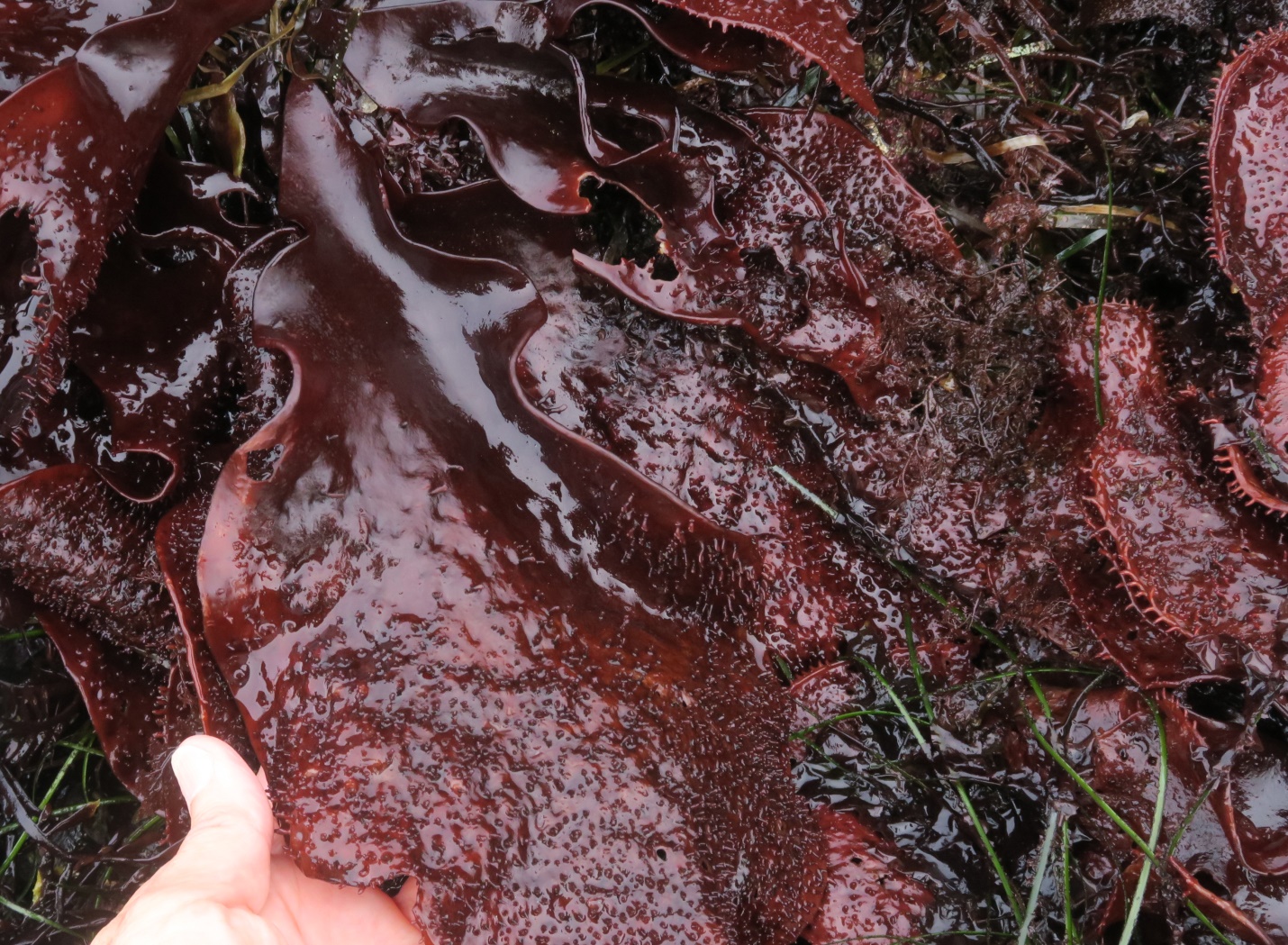
Figure 3: The apophysis area, the area where the stipe widens to the blade, is distinct in this seaweed; it is curved and leathery and sizeable as compares to the overall length of the thallus. Big Beach, Vancouver Island, B.C., Canada. July 22, 2024. Photo ID 27728 ©Seaweedwhisperings.com
Discussion:
Their growth habit can seem “out of control” or living beyond rules and limitations and with few boundaries. How well does that work for you, Chondracanthus corymbiferus? If nothing challenges your living-without-boundaries tendency, then everything is just fine. It’s only a problem when there is a challenge – such as too much blade-sail for oceanic forces.
There can be from others a type of envy, too. If one cannot embody life free from rules and limitations like you do, then there could be a tendency to either disparage or envy this way of being. Disparagement could involve calling names such as: a clown, a fool, a degenerate.
Close inspection of the elaborate “T-shaped” papillae has at times evoked another response – a questioning of the health and vitality of the growth. They can have the look of a type of deformity, certainly as compares to the papillae of other Chondracanthus species, and the nature of that deformity seems to be unrestrained and also excessive growth.
This idea brings up an interesting question – what might be ‘deformed’ or ‘diseased’ in one species may be of no consequence in another, or may even be entirely healthy. What works – health, and what doesn’t work – disease, is very much related to the nature of the individual.
The colors of the reds in this seaweed as seen at low tide fill quite a range; sometimes fiery orange, at other times rich burgundy or blueish red, even sometimes red tinged slightly greenish. This again seems to align with the concept of a kind of ‘unrestricted’ presentation of the color “red”, i.e. they have no desire to conform to one red tone only. The color can draw attention to them. It’s almost like a safety flare; it can catch your attention quickly and even from afar.
The range of colors is also reminiscent of vibrant autumn foliage in hardwoods forests. There is a showy beauty that almost demands attention. And in that beauty, there is also the inherent fact that the color is only on display because work and the active life-sustaining photosynthetic efforts of the foliage is ending for the season. There’s an association with “endings” that is very much a part of the energy of this seaweed.
Upon close inspection there can be something to the look of this seaweed that is not really so ‘lovely’ to take in in detail. The reds show discolorations and variations, and while still bright in tone the look is not ‘prime’ and it can be, certainly in combination with its common epiphyte on board (the hitchhiker red) really rather messy. One could say that they look “organically involved” with their surroundings.
“Astonished” – this word stands out in our interaction and it is almost the polar opposite to another word that came up – “nonchalant”. One can feel astonished after a sudden catastrophic event, a drastic change that is only truly understood sometimes well after the fact. Before any such events occur, however, Chondracanthus corymbiferus does not dwell on worrying or planning for the future; predictions or warnings don’t seem to occupy their awareness. They’re not disregardful of influences that could contribute to their own demise; it feels more as if they are calm, relaxed and accepting of the proximity of these factors. Perhaps we can truly say that this seaweed lives very close to the edge of its mortality, and can do so with comfort.
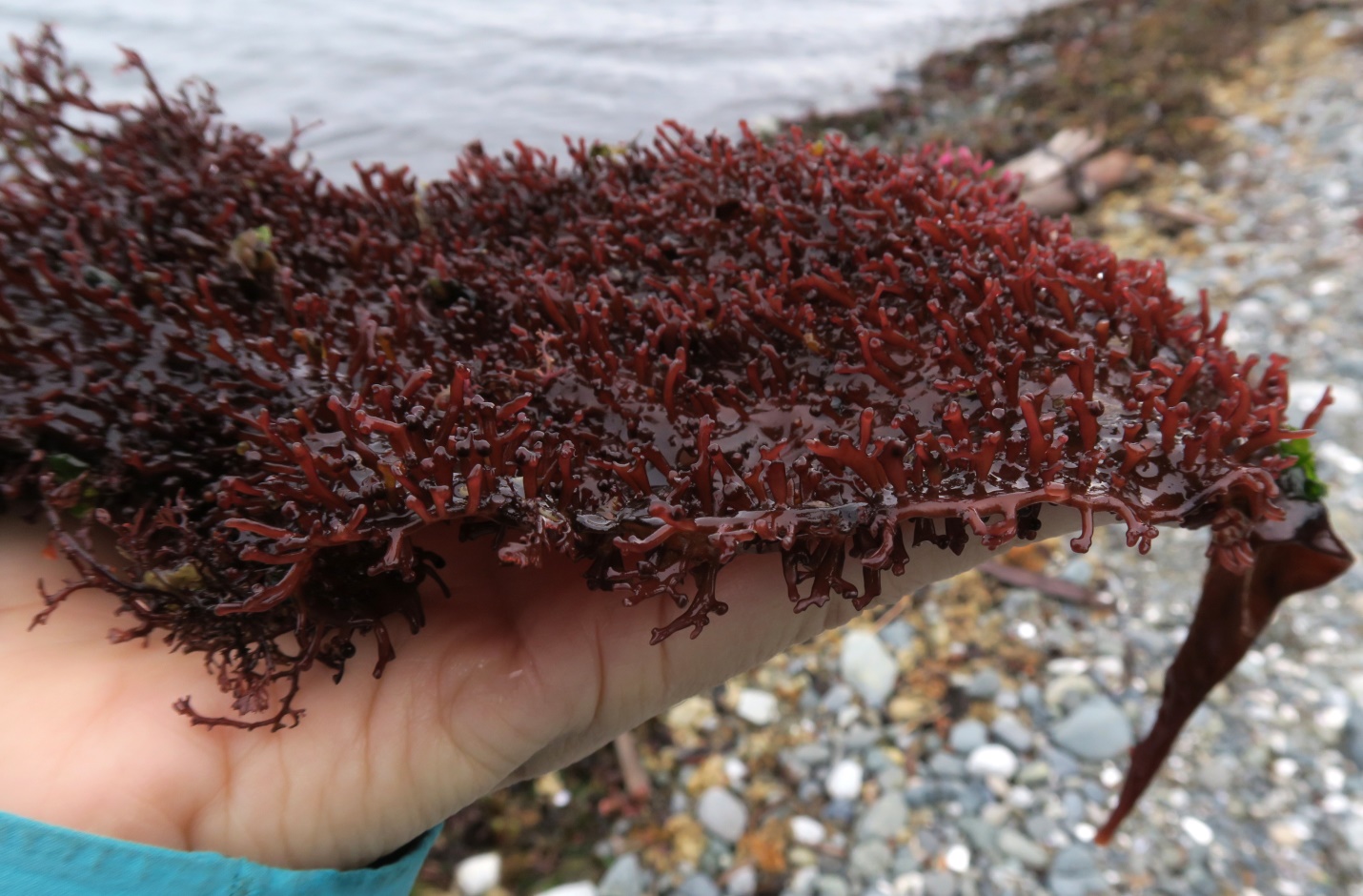
Figure 4: This photograph of a cast ashore blade shows the ‘ornate’ papillae of Chondracanthus corymbiferus. Kye Bay, Strait of Georgia, B.C., Canada. October 19, 2023. Photo ID 27729 ©Seaweedwhisperings.com
Biology & Natural History Information:
Description:
Thalli commonly 20 to 40 cm tall (may approach 80 cm), crisp texture, yellowish-pink to bluish-red, consisting of one to many blades arising from the same discoid holdfast crust. Blade is simple, broadly obovate, with a rounded apex that sometimes can be irregularly split or truncate, but is generally entire. Stipe is short, cylindrical, lacking bladelets (this differentiates C. corymbiferus from C. exasperatus), and merges gradually into a prominent, leathery-textured, wedge-shaped and concavoconvex (convex on one side, concave on the other) apophysis (enlargement) that is 7- 19 cm long. This prominent apophysis forms the base of the large, rounded blade. Elaborate T-shaped papillae cover the blade; no papillae are found on the apophysis. The papillae are vegetative features and are not necessarily associated with reproduction. On mature blades, cystocarps (reproductive projections), 0.8 – 1.2 mm in diameter, appear on all parts including the corymbose papillae, the margins and the blade surfaces. Blades occur in clumps organized by size and age. Younger blades, as well as the basal portions of older blades are iridescent when submerged, while older blades turn yellowish-pink when in the low intertidal. Individuals that are fully subtidal are blueish red.
Habitat:
Common, on rocks in exposed and sheltered locations, low intertidal and subtidal. In much of the range, the largest portion of the population of this species is mainly subtidal. C. exasperatus, a similar species, is found in the low intertidal only, so Chondracanthus corymbiferus is the species more adapted to areas receiving less light and more constant immersion below average tides.
Pacific Coast Distribution:
Barkley Sound, Vancouver Island, BC, to Cabo San Quintin, Baja California, Mexico.
Remarks:
Various species of Chondracanthus are harvested for carrageenan production. The common name of Turkish Towel relates to the rough texture that the numerous papillae give the blade, and indeed some people use this seaweed as a loofah for grooming purposes to remove dead skin.
Classification:
Phylum: Rhodophyta
Class: Florideophyceae
Subclass: Rhodymeniophycidae
Order: Gigartinales
Family: Gigartinaceae
Genus: Chondracanthus
Species: Chondracanthus corymbiferus (Kützing) Guiry 1993
Former name(s):
Homotypic synonyms: Matocarpus corymbiferus Kützing 1847; Gigartina corymbifera (Kützing) J.Agardh 1876. Heterotypic synonyms: Gigartina binghamiae J. Agardh 1899; Gigartina californica J.Agardh 1899.
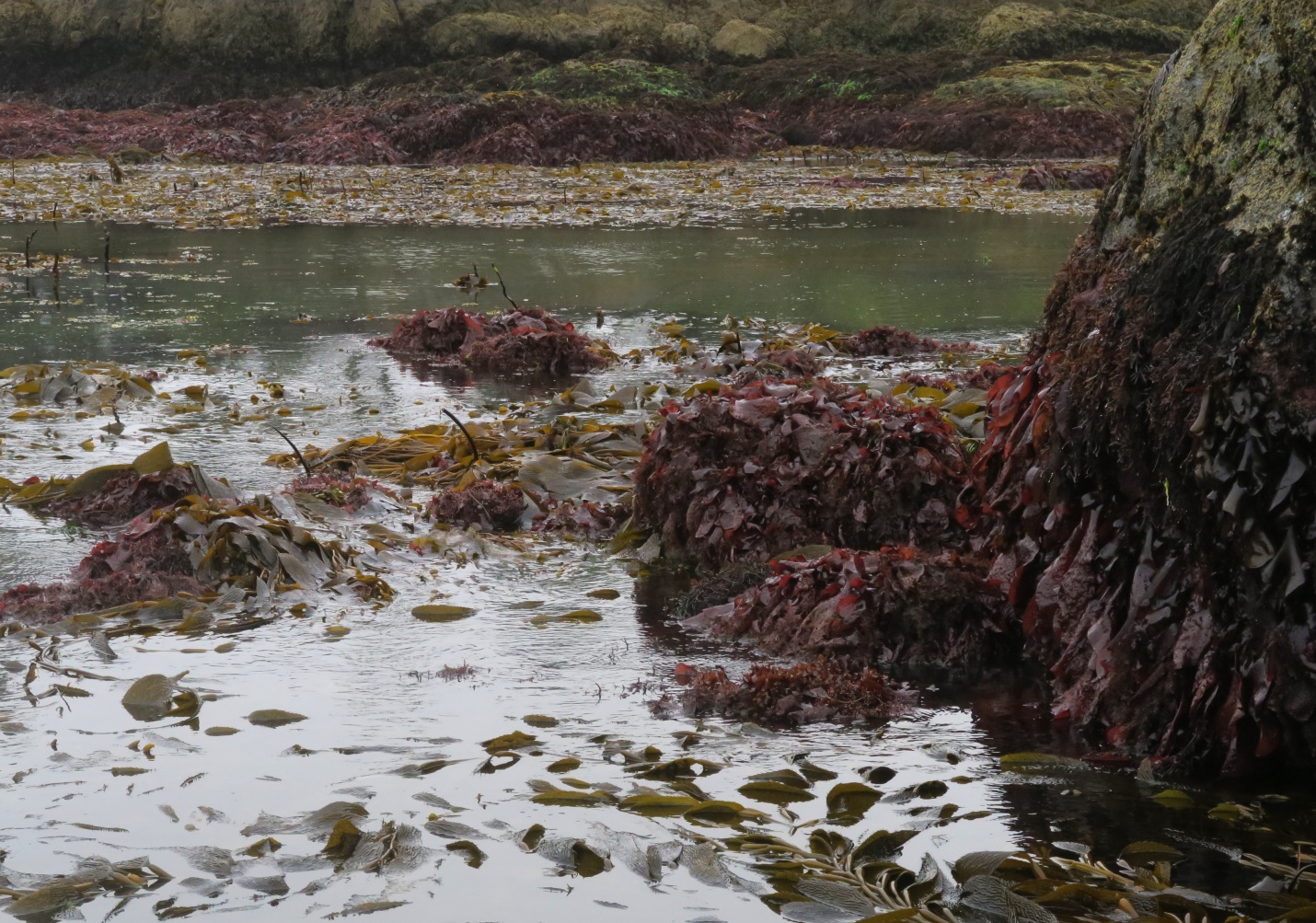
Figure 5: To view the shoreline at Big Beach on a summer low tide morning such as this is to be greeted with scenes comprised of much texture and color – especially a lot of kelp brown contributed by Macrocystis pyriferus and also a lot of red contributed by Chondracanthus corymbiferus. Big Beach, Vancouver Island, B.C., Canada. July 22, 2024. Photo ID 27730 ©Seaweedwhisperings.com
![]()